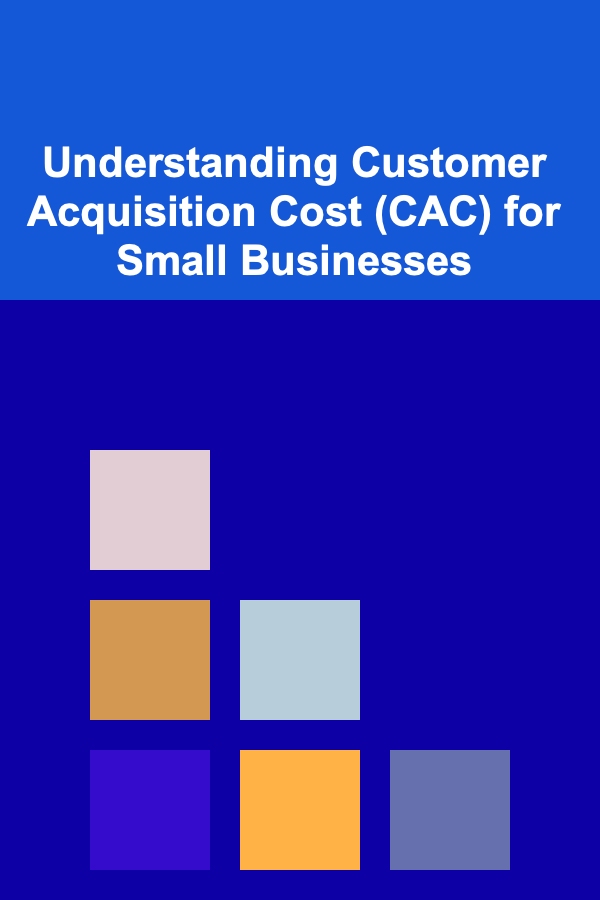
Understanding Customer Acquisition Cost (CAC) for Small Businesses
ebook include PDF & Audio bundle (Micro Guide)
$12.99$10.99
Limited Time Offer! Order within the next:

For small businesses, every dollar counts. Unlike larger corporations with deep pockets, small businesses need to be incredibly strategic and efficient with their spending. One of the most crucial metrics for ensuring long-term profitability and sustainable growth is the Customer Acquisition Cost (CAC). Understanding, calculating, and optimizing CAC can be the difference between thriving and struggling in a competitive marketplace.
What is Customer Acquisition Cost (CAC)?
Customer Acquisition Cost (CAC) represents the total cost associated with acquiring a new customer. It encompasses all the expenses incurred in marketing, sales, and any other related activities that lead a prospect to become a paying customer. It's not just about advertising; it includes salaries, software costs, and everything in between.
Think of it this way: if you spent $1000 on marketing efforts and acquired 10 new customers, your CAC would be $100 per customer. However, arriving at this number requires a more comprehensive understanding of all the associated expenses.
Why is CAC Important for Small Businesses?
CAC is a vital metric for several reasons, especially for small businesses:
- Profitability Analysis: CAC directly impacts your profitability. If your CAC is higher than the revenue you generate from each customer (often referred to as Customer Lifetime Value or CLTV), you're essentially losing money on every new acquisition.
- Marketing ROI: CAC helps you evaluate the effectiveness of your marketing campaigns. By tracking CAC across different channels, you can identify which strategies are most cost-effective and allocate your resources accordingly.
- Investment Decisions: Understanding CAC allows you to make informed decisions about investments in marketing and sales. It provides a concrete basis for justifying expenses and predicting future growth.
- Pricing Strategy: CAC influences your pricing strategy. You need to ensure that your pricing allows you to recover your acquisition costs and generate a profit.
- Fundraising: When seeking funding from investors, a well-defined CAC demonstrates your understanding of your business economics and your ability to acquire customers efficiently. Investors want to see a clear path to profitability, and a low CAC is a positive indicator.
- Business Sustainability: A sustainable business model relies on acquiring customers at a cost that allows for long-term profitability. Monitoring CAC ensures your business is on the right track.
Calculating Customer Acquisition Cost: A Step-by-Step Guide
The basic formula for calculating CAC is: CAC = Total Marketing & Sales Costs / Number of New Customers Acquired
However, accurately determining CAC requires a deeper dive into all the relevant costs. Here's a breakdown of the steps involved:
1. Identify All Marketing and Sales Expenses
This is the most crucial and often the most challenging step. You need to account for every expense related to attracting and converting customers. This includes:
- Advertising Costs: This includes spending on online ads (Google Ads, Facebook Ads, etc.), print ads, radio ads, TV ads, and any other form of paid advertising. Don't forget to include the cost of designing and producing the ads themselves.
- Salaries and Commissions: Include the salaries of your marketing and sales team, as well as any commissions paid to sales representatives for acquiring new customers. Make sure to only allocate the portion of their salary dedicated to acquisition activities. If someone spends 50% of their time on acquisition, include 50% of their salary in the CAC calculation.
- Marketing Software and Tools: Include the costs of any software or tools used for marketing, such as CRM systems, email marketing platforms, social media management tools, analytics software, and marketing automation platforms.
- Content Creation: If you invest in creating content (blog posts, videos, infographics, ebooks, etc.) to attract customers, include the cost of content creation, including salaries of content creators, freelancers, and software used for content production.
- Website Costs: Include the costs associated with your website, such as hosting fees, domain registration, website design and development costs, and any ongoing maintenance or updates. It's best to amortize these costs over the expected lifespan of the website.
- SEO Costs: If you invest in search engine optimization (SEO) to improve your website's ranking in search results, include the costs of SEO services, SEO tools, and any internal resources dedicated to SEO.
- Public Relations (PR): Include the costs of PR activities, such as press releases, media outreach, and hiring a PR agency.
- Trade Shows and Events: If you participate in trade shows or events to attract new customers, include the costs of booth rental, travel expenses, marketing materials, and staff time.
- Promotional Materials: Include the cost of printing brochures, flyers, business cards, and other promotional materials.
- Lead Generation Tools: If you use lead generation tools or services, such as lead magnets or lead capture forms, include the costs associated with these tools.
- Training and Development: Costs associated with training your marketing and sales teams.
Important Considerations:
- Time Period: Define a specific time period for your calculation (e.g., a month, a quarter, or a year). Make sure all your costs and customer acquisitions align with this timeframe.
- Attribution: Accurately attribute costs to acquisition efforts. For example, if a marketing campaign also contributes to brand awareness, you might need to allocate only a portion of the campaign cost to acquisition.
- Hidden Costs: Don't overlook hidden costs, such as employee benefits, office space, and utilities related to marketing and sales activities.
- One-Time vs. Recurring Costs: Distinguish between one-time costs (e.g., website design) and recurring costs (e.g., advertising). Consider amortizing one-time costs over the expected lifespan of the asset.
2. Determine the Number of New Customers Acquired
This seems straightforward, but it's essential to define what constitutes a "new customer." Is it a customer who made their first purchase? A customer who signed up for a free trial? Be consistent in your definition.
Also, ensure you're only counting customers who were acquired as a direct result of your marketing and sales efforts. Don't include organic traffic or referrals that weren't influenced by your campaigns (unless you have a referral program that incurs costs).
Use your CRM or other tracking systems to accurately count the number of new customers acquired during the defined time period.
3. Calculate CAC
Once you have the total marketing and sales costs and the number of new customers acquired, simply divide the total costs by the number of customers to calculate your CAC.
Example:
Let's say your small business spent the following in a month:
- Google Ads: $500
- Facebook Ads: $300
- Marketing Software: $100
- Sales Team Salary (portion dedicated to acquisition): $1000
- Content Creation: $200
Total Marketing & Sales Costs: $500 + $300 + $100 + $1000 + $200 = $2100
During that month, you acquired 20 new customers.
CAC = $2100 / 20 = $105
Therefore, your Customer Acquisition Cost for that month is $105 per customer.
Beyond the Basic Calculation: Segmenting CAC
While the overall CAC provides a general overview, it's often more insightful to segment CAC based on different factors:
1. Channel-Specific CAC
Calculate CAC for each marketing channel you use (e.g., Google Ads CAC, Facebook Ads CAC, Email Marketing CAC). This allows you to identify which channels are most cost-effective and allocate your budget accordingly. The formula remains the same, but you only include costs and new customers that are attributable to that specific channel.
For instance, if your Google Ads campaign cost $500 and resulted in 5 new customers, your Google Ads CAC is $100. If your Facebook Ads campaign cost $300 and resulted in 3 new customers, your Facebook Ads CAC is also $100. However, further analysis might reveal that the Google Ads customers have a higher lifetime value, making it a more profitable channel.
2. Customer Type CAC
If you target different customer segments (e.g., small businesses vs. enterprise customers), calculate CAC separately for each segment. This allows you to understand the cost of acquiring different types of customers and tailor your marketing efforts accordingly.
For example, acquiring an enterprise customer might involve more personalized sales efforts and higher marketing costs, resulting in a higher CAC compared to acquiring a small business customer through a more automated online campaign.
3. Campaign-Specific CAC
Calculate CAC for individual marketing campaigns. This allows you to assess the effectiveness of specific campaigns and identify which campaigns are generating the best return on investment.
For instance, if you run two email marketing campaigns with different subject lines and targeting, calculating the CAC for each campaign will reveal which one is more effective at acquiring new customers.
Benchmarking CAC: Is Your CAC Good or Bad?
Calculating CAC is only the first step. You need to determine whether your CAC is healthy for your business. This requires comparing your CAC to several benchmarks:
1. Customer Lifetime Value (CLTV)
CLTV represents the total revenue you expect to generate from a customer over their entire relationship with your business. A general rule of thumb is that your CLTV should be at least 3 times your CAC (CLTV:CAC ratio of 3:1). This indicates that you're generating enough revenue from each customer to cover your acquisition costs and generate a profit.
Example:
If your CAC is $100 and your CLTV is $500, your CLTV:CAC ratio is 5:1, which is considered healthy.
If your CAC is $100 and your CLTV is $200, your CLTV:CAC ratio is 2:1, which indicates that you need to either increase your CLTV or reduce your CAC.
2. Industry Benchmarks
Research industry benchmarks for CAC. This will give you an idea of how your CAC compares to other businesses in your industry. However, keep in mind that industry benchmarks can vary significantly depending on the specific industry, business model, and target market.
Resources like Statista and industry-specific publications often provide CAC benchmarks for different industries.
3. Historical Data
Track your CAC over time to identify trends and patterns. A rising CAC could indicate increasing competition, declining marketing effectiveness, or changes in your target market. A declining CAC could indicate improved marketing efficiency or more effective sales processes.
4. Competitor Analysis
While it's difficult to know your competitors' exact CAC, you can analyze their marketing strategies and customer acquisition tactics to estimate their CAC. This can provide valuable insights into their marketing effectiveness and help you identify opportunities to improve your own CAC.
Strategies to Reduce Customer Acquisition Cost
Once you understand your CAC and benchmark it against relevant metrics, you can implement strategies to reduce it:
1. Optimize Your Marketing Funnel
Analyze each stage of your marketing funnel (awareness, interest, consideration, decision, action) and identify areas for improvement. This involves optimizing your website, landing pages, email campaigns, and other marketing materials to increase conversion rates at each stage of the funnel.
For example, you could improve your website's user experience, write more compelling ad copy, or offer a more attractive lead magnet.
2. Improve Targeting and Segmentation
Refine your targeting and segmentation to reach the most qualified leads. This involves using data to identify your ideal customer profile and targeting your marketing efforts accordingly. By focusing on the most relevant audience, you can increase conversion rates and reduce wasted ad spend.
For instance, you could use demographic data, behavioral data, and psychographic data to create more targeted ad campaigns.
3. Enhance Customer Retention
Focus on retaining existing customers. Acquiring a new customer is often more expensive than retaining an existing one. By investing in customer loyalty programs, providing excellent customer service, and building strong customer relationships, you can reduce churn and increase customer lifetime value.
For example, you could offer loyalty rewards, personalized support, and exclusive content to your existing customers.
4. Leverage Content Marketing
Create valuable and engaging content that attracts and educates potential customers. Content marketing can be a cost-effective way to generate leads, build brand awareness, and establish yourself as an authority in your industry. By creating content that addresses your target audience's needs and interests, you can attract organic traffic and reduce your reliance on paid advertising.
For instance, you could create blog posts, videos, infographics, ebooks, and webinars that provide valuable information and insights to your target audience.
5. Optimize Your Website for Conversion
Ensure that your website is optimized for conversion. This involves making it easy for visitors to find what they're looking for, providing clear calls to action, and streamlining the checkout process. By improving your website's usability and design, you can increase conversion rates and generate more leads.
For example, you could optimize your website's navigation, improve your website's loading speed, and add compelling testimonials and social proof.
6. Explore Referral Programs
Implement a referral program to incentivize existing customers to refer new customers. Referral programs can be a highly effective way to acquire new customers at a low cost. By rewarding your loyal customers for referring their friends and family, you can tap into a trusted network and generate high-quality leads.
For instance, you could offer discounts, free products, or other incentives to customers who refer new customers.
7. Automate Marketing Processes
Automate repetitive marketing tasks to improve efficiency and reduce costs. Marketing automation tools can help you automate email marketing, social media posting, lead nurturing, and other marketing activities. By automating these tasks, you can free up your team to focus on more strategic initiatives and improve your overall marketing efficiency.
For example, you could use marketing automation software to send automated email sequences to new leads or schedule social media posts in advance.
8. Negotiate Better Rates with Vendors
Negotiate better rates with your marketing and sales vendors. This includes advertising agencies, software providers, and other service providers. By negotiating better rates, you can reduce your overall marketing and sales costs and improve your CAC.
For instance, you could negotiate a lower commission rate with your advertising agency or switch to a more affordable marketing software platform.
Conclusion
Understanding and optimizing Customer Acquisition Cost is essential for the success of any small business. By accurately calculating CAC, benchmarking it against relevant metrics, and implementing strategies to reduce it, you can improve your profitability, increase your marketing ROI, and achieve sustainable growth. Remember that CAC is not a static number; it requires continuous monitoring and optimization as your business evolves and the market changes. Regularly review your CAC, analyze your marketing performance, and adapt your strategies to ensure you're acquiring customers efficiently and profitably. By making CAC a key performance indicator (KPI) and focusing on its improvement, you can build a thriving and sustainable business.

Building a Robust Quality Assurance Framework: Strategies and Case Studies for Success
Read More
From Novice to Expert: Your Path as a Technical Support Engineer
Read More
How To Tile a Bathroom Floor
Read More
The Benefits of Utilizing Free Community Events and Activities for Personal Growth
Read More
How to Support Wildlife Rescue Organizations
Read More
10 Tips for a Christmas Gift List Checklist on a Budget
Read MoreOther Products

Building a Robust Quality Assurance Framework: Strategies and Case Studies for Success
Read More
From Novice to Expert: Your Path as a Technical Support Engineer
Read More
How To Tile a Bathroom Floor
Read More
The Benefits of Utilizing Free Community Events and Activities for Personal Growth
Read More
How to Support Wildlife Rescue Organizations
Read More